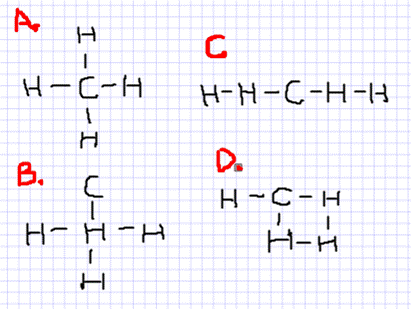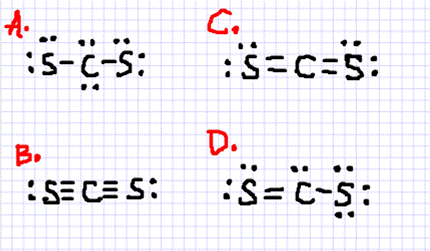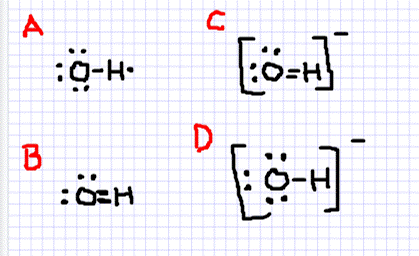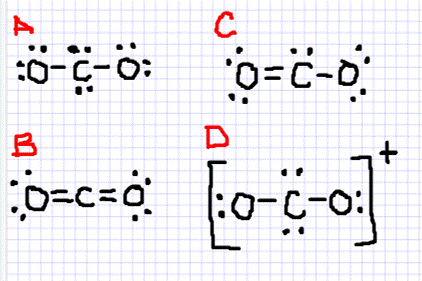Chemical Formulas And Drawing Lewis Diagrams

Tutorials and exercises on chemical formulas and Lewis diagrams
Questions and Answers
- 1.
Study the following tutorial on writing chemical formulas of ionic compounds.
- 2.
Write the chemical formula of: aluminum sulfide
Correct Answer
Al2S3Explanation
The chemical formula for aluminum sulfide is Al2S3. This formula indicates that there are two aluminum atoms (Al) and three sulfur atoms (S) present in one molecule of aluminum sulfide. The subscript numbers indicate the ratio of atoms in the compound.Rate this question:
- 3.
Write the chemical formula of: calcium phosphate
Correct Answer
Ca3(PO4)2Explanation
The chemical formula for calcium phosphate is Ca3(PO4)2. This formula represents the compound composed of one calcium ion (Ca2+) bonded with three phosphate ions (PO43-). The subscript numbers indicate the number of atoms of each element present in the compound.Rate this question:
- 4.
Write the chemical formula of: tin (IV) oxide
Correct Answer
SnO2Explanation
Tin (IV) oxide is represented by the chemical formula SnO2. In this compound, tin is in its +4 oxidation state, hence the Roman numeral IV in the name. The oxide ion (O2-) combines with the tin ion (Sn4+) to form the compound. The formula SnO2 indicates that there are two oxygen atoms for every tin atom in the compound.Rate this question:
- 5.
Write the chemical formula of: iron(III) sulfate
Correct Answer
Fe2(SO4)3Explanation
The chemical formula for iron(III) sulfate is Fe2(SO4)3. This compound consists of two iron (Fe) atoms and three sulfate (SO4) ions. The Roman numeral III in the name indicates that iron has a +3 oxidation state. Sulfate is a polyatomic ion composed of one sulfur atom and four oxygen atoms, with a -2 charge. To balance the charges, two iron atoms with a +3 charge each combine with three sulfate ions with a -2 charge each. Therefore, the correct chemical formula for iron(III) sulfate is Fe2(SO4)3.Rate this question:
- 6.
Write the chemical formula of: ammonium dichromate
Correct Answer
(NH4)2Cr2O7Explanation
The chemical formula of ammonium dichromate is (NH4)2Cr2O7. This compound consists of two ammonium ions (NH4+) and two dichromate ions (Cr2O7^2-). The ammonium ion consists of one nitrogen atom bonded to four hydrogen atoms, while the dichromate ion consists of two chromium atoms bonded to seven oxygen atoms. The subscript numbers indicate the number of each ion present in the compound.Rate this question:
- 7.
Write the name of: AlCl3
Correct Answer
aluminum chlorideExplanation
The correct answer is aluminum chloride because AlCl3 is the chemical formula for this compound. It is formed by the combination of one aluminum atom with three chlorine atoms. Aluminum chloride is a white solid that is commonly used as a catalyst in various chemical reactions.Rate this question:
- 8.
Write the name of: Sr3(PO4)2
Correct Answer
strontium phosphateExplanation
The correct answer is "strontium phosphate" because Sr3(PO4)2 is the chemical formula for this compound. It consists of three strontium ions (Sr2+) and two phosphate ions (PO43-). The name "strontium phosphate" accurately describes the composition of the compound, indicating that it contains strontium and phosphate ions.Rate this question:
- 9.
Write the name of: Sn3(PO4)2
Correct Answer
tin(II) phosphateExplanation
The name "tin(II) phosphate" is correct for the compound Sn3(PO4)2. This is because the compound contains tin (Sn) in its +2 oxidation state, and phosphate (PO4) as the anion. The Roman numeral II in the name indicates the oxidation state of tin, while "phosphate" indicates the presence of the PO4 anion.Rate this question:
- 10.
Write the name of: NH4ClO3
Correct Answer
ammonium chlorateExplanation
NH4ClO3 is the chemical formula for ammonium chlorate. Ammonium refers to the NH4+ ion, which is a positively charged ion consisting of one nitrogen atom bonded to four hydrogen atoms. Chlorate refers to the ClO3- ion, which is a negatively charged ion consisting of one chlorine atom bonded to three oxygen atoms. Therefore, when these ions combine, they form NH4ClO3, which is known as ammonium chlorate.Rate this question:
- 11.
Study the following tutorial on writing formulas of covalent compounds.
- 12.
Write the formula of: carbon disulfide
Correct Answer
CS2Explanation
The correct formula for carbon disulfide is CS2. This compound consists of one carbon atom bonded to two sulfur atoms. The subscript "2" indicates that there are two sulfur atoms present in the molecule. The formula CS2 is derived from the chemical symbols of carbon (C) and sulfur (S), with the number 2 indicating the number of sulfur atoms.Rate this question:
- 13.
Write the formula of: sulfur hexafluoride
Correct Answer
SF6Explanation
The correct answer, SF6, is the formula for sulfur hexafluoride. Sulfur hexafluoride is a chemical compound composed of one sulfur atom and six fluorine atoms. It is a colorless, odorless gas that is widely used in various industries due to its excellent electrical insulating properties. The formula SF6 represents the specific arrangement of atoms in this compound, with the sulfur atom at the center surrounded by six fluorine atoms.Rate this question:
- 14.
Write the name of: Cl2O7
Correct Answer
dichlorine heptoxideExplanation
Dichlorine heptoxide is the correct name for the compound Cl2O7. The prefix "di-" indicates that there are two chlorine atoms, and "hept-" indicates that there are seven oxygen atoms. The suffix "-oxide" indicates that the compound contains oxygen. Therefore, the name "dichlorine heptoxide" accurately describes the composition of Cl2O7.Rate this question:
- 15.
Write the name of: P2O5
Correct Answer
diphosphorus pentoxideExplanation
Diphosphorus pentoxide is the correct name for the compound P2O5. It is composed of two phosphorus atoms bonded to five oxygen atoms. The prefix "di-" indicates the presence of two phosphorus atoms, while "pent-" indicates the presence of five oxygen atoms. The suffix "-oxide" signifies that the compound contains oxygen. Therefore, the name "diphosphorus pentoxide" accurately describes the composition of P2O5.Rate this question:
- 16.
Study the following videos.
- 17.
Which of the following is the correct Lewis structure for CH4
- A.
A
- B.
B
- C.
C
- D.
D
Correct Answer
A. AExplanation
The correct Lewis structure for CH4 is A. In this structure, the carbon atom is located at the center, and it is bonded to four hydrogen atoms. Each hydrogen atom is represented by a single bond, and the carbon atom has a total of four valence electrons. This arrangement satisfies the octet rule for both carbon and hydrogen, as they both have a full outer shell of electrons.Rate this question:
-
- 18.
How many electrons should be shown in the Lewis structure of HNO3
Correct Answer
24Explanation
In the Lewis structure of HNO3, there are a total of 24 electrons that should be shown. This can be determined by considering the valence electrons of each atom in the molecule. Hydrogen (H) has 1 valence electron, Nitrogen (N) has 5 valence electrons, and Oxygen (O) has 6 valence electrons. Since there are 3 Hydrogen atoms, one Nitrogen atom, and 3 Oxygen atoms in HNO3, the total number of valence electrons is calculated as (3 * 1) + 5 + (3 * 6) = 24. Therefore, the Lewis structure of HNO3 should show 24 electrons.Rate this question:
- 19.
Which is the correct Lewis structure for carbon disulfide?
- A.
A
- B.
B
- C.
C
- D.
D
Correct Answer
C. CExplanation
The correct Lewis structure for carbon disulfide is C. Carbon disulfide consists of one carbon atom bonded to two sulfur atoms. Carbon has four valence electrons and sulfur has six valence electrons. To satisfy the octet rule, carbon forms double bonds with both sulfur atoms, resulting in a linear molecule. The Lewis structure for carbon disulfide shows the carbon atom in the center, with two double bonds to the sulfur atoms.Rate this question:
-
- 20.
How many electrons should be shown in the Lewis structure of phosphorus pentachloride?
Correct Answer
40
fortyExplanation
The Lewis structure of phosphorus pentachloride (PCl5) consists of a central phosphorus atom bonded to five chlorine atoms. Each chlorine atom contributes one electron to form a covalent bond with the phosphorus atom. Phosphorus has five valence electrons, and each chlorine atom has seven valence electrons. Therefore, the total number of electrons in the Lewis structure of PCl5 is 5 + (5 * 7) = 40. The answer "40" and "forty" both indicate the correct number of electrons needed for the Lewis structure of phosphorus pentachloride.Rate this question:
- 21.
How many single bonds can be shown in the Lewis structure of NH3
Correct Answer
3
threeExplanation
In the Lewis structure of NH3, each hydrogen atom forms a single bond with the nitrogen atom. Since there are three hydrogen atoms in NH3, there will be three single bonds in its Lewis structure.Rate this question:
- 22.
How many electrons should be shown in the Lewis structure of a carbonate ion?
Correct Answer
24
twenty fourExplanation
The Lewis structure of a carbonate ion consists of one carbon atom bonded to three oxygen atoms. Each oxygen atom contributes two electrons, and the carbon atom contributes four electrons. Therefore, the total number of electrons shown in the Lewis structure of a carbonate ion is 24.Rate this question:
- 23.
Which of the following is the correct Lewis structure for OH-
- A.
A
- B.
B
- C.
C
- D.
D
Correct Answer
D. DExplanation
The correct Lewis structure for OH- is D. In this structure, oxygen is the central atom bonded to a hydrogen atom. Oxygen has 6 valence electrons and hydrogen has 1 valence electron. Oxygen has two lone pairs of electrons and a single bond with hydrogen, giving it a total of 8 electrons. This structure satisfies the octet rule for both oxygen and hydrogen. The negative charge on the hydroxide ion is represented by an extra lone pair of electrons on oxygen.Rate this question:
-
- 24.
What type of bond can be seen in the Lewis structure of carbon dioxide?
- A.
Single
- B.
Double
- C.
Triple
Correct Answer
B. DoubleExplanation
In the Lewis structure of carbon dioxide, there are two double bonds between the carbon atom and each oxygen atom. A double bond is formed when two pairs of electrons are shared between two atoms. Therefore, the correct answer is double.Rate this question:
-
- 25.
Which of the following is the correct Lewis structure for carbon dioxide?
- A.
A
- B.
B
- C.
C
- D.
D
Correct Answer
B. BExplanation
Lewis structures are used to represent the bonding and electron distribution in molecules. In the case of carbon dioxide (CO2), carbon is the central atom and is bonded to two oxygen atoms. Each oxygen atom has 6 valence electrons, and carbon has 4 valence electrons. The Lewis structure for CO2 should show the carbon atom in the center with double bonds to both oxygen atoms, and each oxygen atom should have 2 lone pairs of electrons. Answer B correctly represents this arrangement, with the carbon atom in the center and double bonds to both oxygen atoms.Rate this question:
-
Quiz Review Timeline +
Our quizzes are rigorously reviewed, monitored and continuously updated by our expert board to maintain accuracy, relevance, and timeliness.
-
Current Version
-
Mar 22, 2023Quiz Edited by
ProProfs Editorial Team -
Nov 17, 2011Quiz Created by
Dropoffpoints





